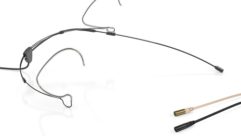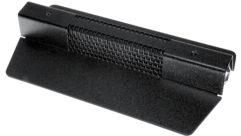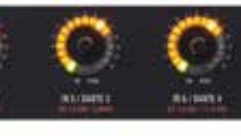
DPA BLM4060
Feb 1, 2007 12:00 PM,
By John McJunkin

DPA’s microphones have long been popular in the world of recording — and rightfully so. DPA has incredible microphone products that capture high-fidelity recordings of all kinds of musical instruments. When the company recently introduced its BLM4060 boundary-layer microphone, I found myself intrigued to hear what kind of quality the company had achieved. Of course, there are numerous manufacturers that make excellent pressure-zone or boundary-layer mics for boardroom or teleconferencing use, but I could hardly wait to get my ear on DPA’s offering.
SMART LOOKS
Aside from its acoustic capabilities, the microphone is aesthetically pleasing for applications in which looks matter, including board meetings, conferences, and court rooms. The mic itself is housed in a black rubber disc centered within a 4in.-diameter stainless-steel ring that gently slopes from the center to the outer circumference. On one side of the ring, there is an opening that accommodates the mic’s connector — DPA’s proprietary MicroDot design. Not quite centered in the top of the black rubber disc is the aperture through which sound is captured. The pre-polarized condenser contained within is 0.2in., and is vertically oriented. Phantom power is necessary for the microphone, and as usual, DPA’s design is very forgiving, operating on a range of voltage from 5V to 50V.
The frequency range of the mic is from 20Hz to 14kHz, plus or minus 2dB. A boost in frequency response starts at 2kHz and slopes up to a maximum of 7dB at 8kHz. DPA characterizes this as a “soft” boost, but regardless of your perception of what is soft and what is substantial, the boost increases the clarity and intelligibility of this microphone in an almost magical way.
Obviously, the primary application for the mic is for the capture of the human voice — although I am aware of orchestral recordings being made with boundary-layer microphones mounted above the string sections — and the intelligibility frequencies are perfectly boosted here. I recorded a conversation around a board table with a single BLM4060, and I was absolutely thrilled with the clarity.
DIFFUSE SOUND REJECTION
Boundary-layer and pressure-zone microphones benefit from being placed on flat, open surfaces to create a “half-space” sound field, and the BLM4060 is no exception. According to DPA’s specifications, the microphone will exhibit a 6dB gain of direct sound and only a 3dB gain of diffuse sound when used in this way — and this is a substantial difference. In the case of the recording I made, there were people seated directly at the board table, and others seated away from the table. Those seated at the table were captured very clearly. Those seated further from the table were a bit more diffuse, but they were sufficiently audible and clear in the recording — particularly after some dynamics processing.
It became quite apparent to me that using this microphone in a nominally absorptive space would yield tight recordings that clearly express what was said. That’s where this microphone really shines — it rejects the diffuse sound field effectively. Again, both those seated directly at the table and those seated a bit further away were very clear in the test recording, but there was very little to be heard in the way of reflections and diffuse reverberation.
The magic to which I alluded earlier is the fact that this mic has a pretty large bump above 2kHz and resolving at about 14kHz. Looking at the graph without hearing the mic, one might reach the conclusion that the diffuse sound field is going to be more prominent in the signal captured by the mic than it actually is. But this is simply not the case. The design results in an emphasis of those intelligibility frequencies, but only in the direct field. There are no high-frequency reflections bouncing around — just a nice, tight, direct field, with only hints of the space around.
I used absolutely no EQ in my test recording — it simply wasn’t necessary. This is one of the hallmarks of DPA microphones: They capture things the way they really sound, and it takes no tweaking to improve the recording. The mic is also sufficiently quiet, with an A-weighted equivalent noise level that is no greater than 26dB. It can also handle some pretty substantial SPL, with less than 1 percent total harmonic distortion at peaks of 123dB SPL or 120dB SPL RMS with a sine wave. It can drive a cable up to 300m in length, likely more than enough for nearly all applications. It exhibits a typical dynamic range of 100dB and its signal-to-noise ratio is 71dB (A-weighted), measured with a 1kHz wave at 94dB SPL. Bottom line: It’s clean, quiet, and accurate.
In fact, I have only one tiny complaint about the BLM4060. DPA’s MicroDot connector works exceedingly well for many of its microphones. It’s actually a necessity for some of the manufacturers’ tiny mics that sound incredible, such as the 4061. In this case, however, the MicroDot connector requires the cable to enter the body of the microphone parallel to the plane of the microphone. Thus, even if a hole is drilled in the table for the cable, the cable will be exposed at least a bit. Is this a ticky-tack grumble? Unquestionably. In the course of balancing out the visual aesthetics of the microphone versus the quality of the sound it delivers, I would not hesitate to use it even in the most aesthetically sensitive conditions. And even with slight cable exposure, the mic remains visually gorgeous. Still, in a perfect world, I’d prefer to see the cable 100 percent concealed.
FINAL WORD
The BLM4060 is yet another in a long line of incredible products from DPA. I plan on acquiring at least one to use in podcast production, and my prediction is that it will become my singular mic of choice whenever it’s necessary for me to record a conference around a boardroom table. With just the slightest bit of acoustical treatment, I’ll be able to get studio quality in a business environment. The 7dB bump at 8kHz may look a little unorthodox, but at the end of the day, the clarity is astonishing. If you require a mic for similar applications, I strongly recommend the BLM4060.
PRODUCT SUMMARY
Company: DPA Microphones
www.dpamicrophones.com
Pros: Excellent rejection of diffuse sound.
Cons: Cable not easily concealed in install conditions.
Applications: Boardrooms, conference facilities, court rooms, teleconferencing.
Price: $749
SPECIFICATIONS
Principle of operation: Pressure
Cartridge type: Pre-polarized vertical diaphragm condenser
Power supply: 5V-50V via DPA adapter
Frequency range: ±2dB: 20Hz-14kHz (with 7dB soft boost at 8kHz)
Directional characteristics: Omnidirectional, half space
Equivalent noise level (A-weighted): Typically 23dB(A) re. 20µPa (max. 26dB)
Equivalent noise level (ITU-R BS.468-4): Typically 35dB (max. 38dB)
Total harmonic distortion (THD): 1% up to 123dB SPL peak; 1% 120dB SPL RMS sine
Output impedance: 30Ω-40Ω
Cable drive capability: Up to 300m
Max. SPL, peak before clipping: 134dB
Weight: 8.2oz. excluding cable
Cable length: 3m
Cable color: Black
Dimensions: 4″×1/2″
Dynamic Range: Typically 100dB
S/N Ratio re. 1kHz at 1Pa (94dB SPL): 71dB(A)
Connector: MicroDot
Sensitivity: nominal, ±3dB: 20mV/Pa at 1kHz; -34dB re. 1V/Pa
John McJunkinis the principal of Avalon Podcasting in Chandler, Ariz. He has consulted in the development of studios and installations, and provides high-quality podcast production services.









